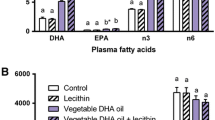Abstract
Because alterations in the dietary content of fatty acids are an important method for modulating macrophage eicosanoid production, we have quantitated the levels of n−6 and n−3 polyunsaturated fatty acids in peritoneal macrophage individual phospholipids from mice fed diets (3 wk) with either safflower oil (SAF), predominantly containing 18∶2n−6, borage (BOR) containing 18∶2n−6 and 18∶3n−6, fish (MFO) containing 20∶5n−3 and 22∶6n−3, and borage/fish mixture (MIX) containing 18∶2n−6, 18∶3n−6, 20∶5n−3 and 22∶6n−3. Dietary n−3 fattya cids were readily incorporated into macrophage phosphatidylcholine (PC), phosphatidylethanolamine (PE), phosphatidylserine (PS) and phosphatidylinositol (PI). The increase in n−3 fatty acid levels was accompanied by a decrease in the absolute levels of 18∶2n−6, 20∶4n−6 and 22∶4n−6 in PC, PE and PS. Interestingly, PI 20∶4n−6 levels were not significantly lowered (P>0.05) in MIX and MFO macrophages relative to SAF and BOR. These data demonstrate the unique ability of this phospholipid to selectively maintain its 20∶4n−6 levels. In BOR and MIX animals, 20∶3n−6 levels were significantly increased (P<0.05) in all phospholipids relative to SAF and MFO. The combination of borage and fish oils (MIX diet) produced the highest 20∶3n−6/20∶4n−6 ratio in all phospholipids. These data show that the macrophage eicosanoid precursor levels of 20∶3n−6, 20∶4n−6 and n−3 acids can be selectively manipulated through the use of specific dietary regimens. This is noteworthy because an increase in phospholipid levels of 20∶3n−6 and 20∶5n−3, while concomitantly reducing 20∶4n−6, may have therapeutic potential in treating inflammatory disorders.
Similar content being viewed by others
Abbreviations
- BOR:
-
borage
- FAME:
-
fatty acid methyl esters
- MFO:
-
fish
- MIX:
-
borage/fish mixture
- PC:
-
phosphatidylcholine
- PE:
-
phosphatidylethanolamine
- PI:
-
phosphatidylinositol
- PS:
-
phosphatidylserine
- SAF:
-
safflower oil
- TLC:
-
thin layer chromatography
References
Somers, S.D., Johnson, W.J., and Adams, D.O. (1986) inCancer Immunology: Innovative Approaches to Therapy (Herberman, R., ed.) pp. 69–122, Martinus Nijhoff, Boston, MA.
Stenson, W.F., and Parker, C.W. (1980)J. Immunol. 125, 1–6.
Schultz, R.M., Parlidis, N.A., Stylos, W.A., and Chirigos, M.A. (1979)Science 202, 320–321.
Snyder, D.S., Beller, D.I., and Unanue, E. (1982)Nature London 299, 163–165.
Taffet, S.M., and Russell, S.W. (1981)J. Immunol. 126, 424–427.
Schnyder, J., Dewald, B., and Baggiolini, M. (1981)Prostaglandins 22, 411–421.
Mathias, M.M., and Dupont, J. (1985)Lipids 20, 791–801.
Willis, A.L. (1981)Nutr. Rev. 39, 289–301.
Chapkin, R.S., Somers, S.D., Schumacher, L., and Erickson, K.L. (1988)Lipids 23, 380–383.
Terano, T., Salmon, J.A., Higgs, G.A., and Moncada, S. (1986)Biochem. Pharmacol. 35, 779–785.
Kunkel, S.L., Ogawa, H., Ward, P.A., and Zurier, R.B. (1981)Prog. Lipid Res. 20, 885–889.
Horrobin, D.F. (1983)Rev. Pure Appl. Sci. 4, 339–383.
Brown, M.L., Jakubowski, J.A., Leventis, L.L., and Deykin, D. (1987)Biochim. Biophys. Acta 921, 159–166.
Mahadevappa, V.G., and Holub, B.J. (1987)J. Lipid Res. 28, 1275–1280.
Meltzer, M.S. (1976)Cell Immunol. 75, 176–186.
Erickson, K.L., Schlanger, D.S., Adams, D.A., Fregeau, D.R., and Stern, J.S. (1984)J. Nutr. 114, 1834–1842.
National Research Council (1978) inNutrient Requirements of Laboratory Animals, Vol. 10, pp. 38–53, National Academy of Sciences, Washington, D.C.
Chapkin, R.S., Somers, S.D., and Erickson, K.L. (1988)J. Immunol. 140, 2350–2355.
Folch, J., Lees, M., and Sloane-Stanley, G.H. (1957)J. Biol. Chem. 22, 497–509.
Holub, B.J., and Skeaff, C.M. (1987)Meth. Enzymol. 141, 234–244.
Chapkin, R.S., Haberstroh, B., Liu, T., and Holub, B.J. (1983)J. Lab. Clin. Med. 101, 726–735.
Chapkin, R.S., Ziboh, V.A., Marcelo, C.L., and Voorhees, J.J. (1986)J. Lipid Res. 27, 945–954.
Schmidt, G., Martin, A.P., Stuhlman, R.A., Townsend, J.F., Lucas, F.V., and Vorbeck, M.L. (1984)Lab. Invest. 30, 451–457.
Chapkin, R.S., Miller, C.C., Somers, S.D., and Erickson, K.L. (1988)Biochim. Biophys. Acta 959, 322–331.
Lokesh, B.R., Hsieh, H.L., and Kinsella, J.E. (1986)J. Nutr. 116, 2547–2552.
Magrum, L.J., and Johnston, P.V. (1983)Lipids 18, 514–521.
Chensue, S.W., and Kunkel, S.L. (1983)Clinics Lab. Med. 3, 677–694.
Kernoff, P.B.A., Willis, A.L., Stone, K.J., Davies, J.A., and McNicol, G.P. (1977)Br. Med. J. 2, 1441–1444.
Takahashi, R., Nassar, B.A., Huang, Y.S., Begin, M.E., and Horrobin, D.F. (1987)Throm. Res. 47, 135–146.
Juan, H., and Sametz, W. (1985)Naunyn-Schmied. Arch. Pharmacol. 329, 388–393.
Author information
Authors and Affiliations
About this article
Cite this article
Chapkin, R.S., Somers, S.D. & Erickson, K.L. Dietary manipulation of macrophage phospholipid classes: Selective increase of dihomogammalinolenic acid. Lipids 23, 766–770 (1988). https://doi.org/10.1007/BF02536219
Received:
Accepted:
Issue Date:
DOI: https://doi.org/10.1007/BF02536219




